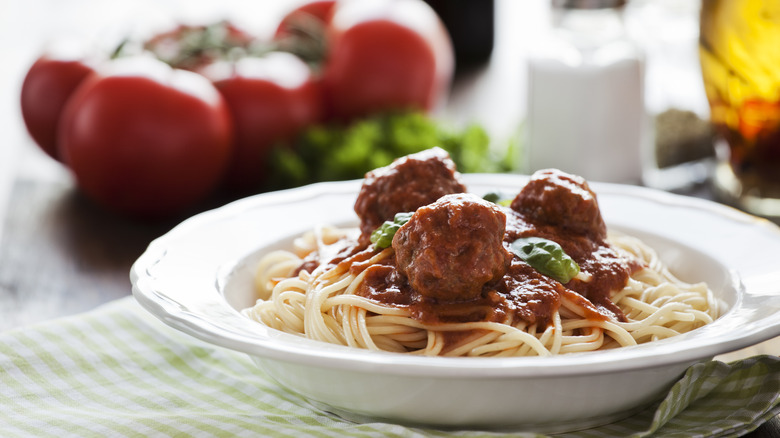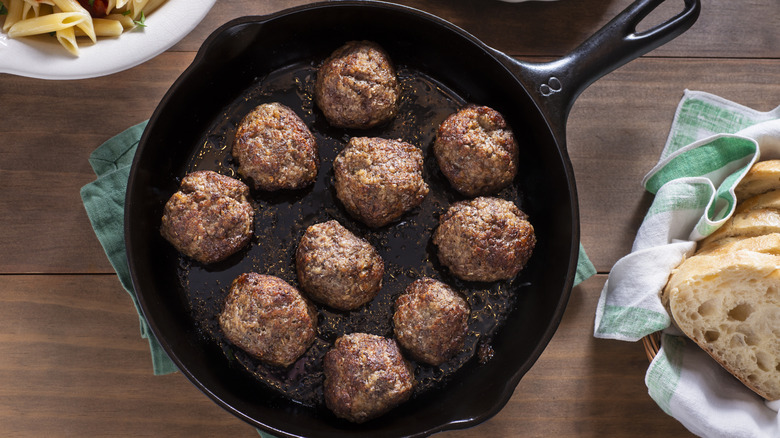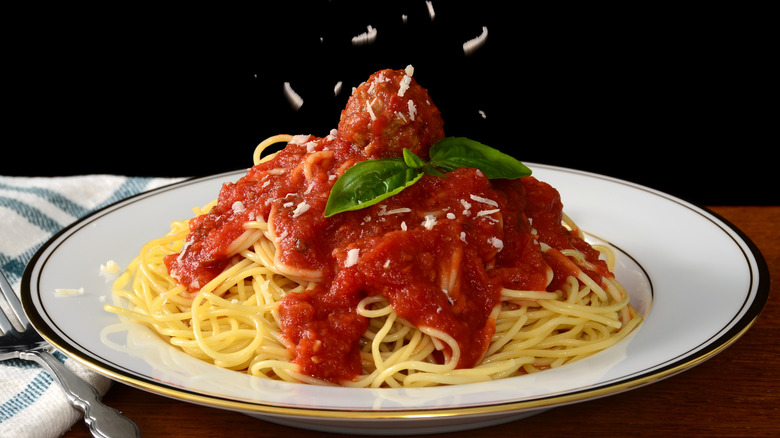Nope, Spaghetti And Meatballs Isn't Really An Italian Dish
Ask any American to name the quintessential Italian dish and the answer is likely to be spaghetti and meatballs. It's so basic as to be foundational: large, round balls made of meat, egg, breadcrumbs, and grated Parmesan cheese perched atop a plate of thin wheat noodles, bathed in a simple yet satisfying marinara sauce. Spaghetti and meatballs is not only the perfect blend of protein and starch, it's also definitively Italian. Except it's not. Spaghetti and meatballs is a purely American invention, as are many other dishes that fall under the umbrella of Italian American cuisine.
Americans are like this. Many of us are quick to tell you about our ancestry — especially with the advent of genomic testing technology. "I'm Scottish and German," someone might say, despite the fact they were born in Sheboygan. So it makes sense that we might claim the same roots for our food. But when you look at the origins of spaghetti and meatballs, it becomes obvious that it couldn't be anything other than an integral part of American cuisine. Sure, it was almost certainly created by Italian immigrants, but was shaped by purely domestic circumstances. However, there are some Italian culinary counterparts that inspired this Americanized dish.
Italian polpettes
Let's start with meatballs. You're not going to find anything in Italy that resembles an American meatball. If anything, they look more like Swedish kötbullar or Middle Eastern kofta. This makes sense — given the fact that it's generally agreed that Italians didn't start eating pasta until the Arab invasion of Sicily in the 8th century, it's possible that meatballs were also introduced at that time as well. At any rate, Italians do eat meatballs: They're called polpettes, and they are not only typically much smaller than the American version, but they're also usually served by themselves unaccompanied by pasta or sauce. Additionally, polpettes can be made from anything from fish to lamb, depending on the season and region.
Americans got their big ol' meatballs from the wave of Italian immigrants who settled here between 1880 and 1920 — most of whom came from Southern Italy. In contrast to their homeland, meat was plentiful in the States; especially beef. Naturally, this nutritious food was incorporated into the home cook's menu and consequently, the polpettes transformed into meatballs, increasing both in size and meat-to-bread ratio.
Spaghetti and marinara, American style
Sure, Italians eat spaghetti, but not like Americans — who prefer it (or similarly long, thin noodles) when consuming their estimated 20 pounds of pasta per person every year. Additionally, Italian pasta portions are almost never as large as American portions and tend to be served as a kind of appetizer. Immigrants adopted it as the starchy part of a main course, in portions comparable to their Americanized meatballs.
Lastly, Italians don't exclusively smother every pasta dish with a red sauce, which originates from and remains most popular in the southern part of the country. But when pretty much the only Italian food on offer in early-20th century grocery stores was pasta and canned tomatoes, immigrants dressed their spaghetti and meatballs with a quick-and-easy marinara sauce, so-named because housewives could put some "sailor sauce" together between the time they saw their fisherman husbands return to port and his arrival at home — the Italian word marinara directly translates to "seafaring", or, colloquially, "sailor style." (The history behind the name marinara sauce is worth a deep dive in and of itself.)


